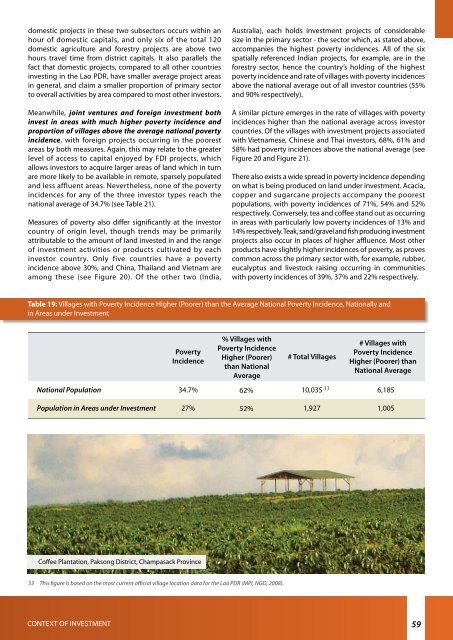Concessions and Leases in the Lao PDR
Concessions and Leases in the Lao PDR
Concessions and Leases in the Lao PDR
Create successful ePaper yourself
Turn your PDF publications into a flip-book with our unique Google optimized e-Paper software.
domestic projects <strong>in</strong> <strong>the</strong>se two subsectors occurs with<strong>in</strong> an<br />
hour of domestic capitals, <strong>and</strong> only six of <strong>the</strong> total 120<br />
domestic agriculture <strong>and</strong> forestry projects are above two<br />
hours travel time from district capitals. It also parallels <strong>the</strong><br />
fact that domestic projects, compared to all o<strong>the</strong>r countries<br />
<strong>in</strong>vest<strong>in</strong>g <strong>in</strong> <strong>the</strong> <strong>Lao</strong> <strong>PDR</strong>, have smaller average project areas<br />
<strong>in</strong> general, <strong>and</strong> claim a smaller proportion of primary sector<br />
to overall activities by area compared to most o<strong>the</strong>r <strong>in</strong>vestors.<br />
Meanwhile, jo<strong>in</strong>t ventures <strong>and</strong> foreign <strong>in</strong>vestment both<br />
<strong>in</strong>vest <strong>in</strong> areas with much higher poverty <strong>in</strong>cidence <strong>and</strong><br />
proportion of villages above <strong>the</strong> average national poverty<br />
<strong>in</strong>cidence, with foreign projects occurr<strong>in</strong>g <strong>in</strong> <strong>the</strong> poorest<br />
areas by both measures. Aga<strong>in</strong>, this may relate to <strong>the</strong> greater<br />
level of access to capital enjoyed by FDI projects, which<br />
allows <strong>in</strong>vestors to acquire larger areas of l<strong>and</strong> which <strong>in</strong> turn<br />
are more likely to be available <strong>in</strong> remote, sparsely populated<br />
<strong>and</strong> less affluent areas. Never<strong>the</strong>less, none of <strong>the</strong> poverty<br />
<strong>in</strong>cidences for any of <strong>the</strong> three <strong>in</strong>vestor types reach <strong>the</strong><br />
national average of 34.7% (see Table 21).<br />
Measures of poverty also differ significantly at <strong>the</strong> <strong>in</strong>vestor<br />
country of orig<strong>in</strong> level, though trends may be primarily<br />
attributable to <strong>the</strong> amount of l<strong>and</strong> <strong>in</strong>vested <strong>in</strong> <strong>and</strong> <strong>the</strong> range<br />
of <strong>in</strong>vestment activities or products cultivated by each<br />
<strong>in</strong>vestor country. Only five countries have a poverty<br />
<strong>in</strong>cidence above 30%, <strong>and</strong> Ch<strong>in</strong>a, Thail<strong>and</strong> <strong>and</strong> Vietnam are<br />
among <strong>the</strong>se (see Figure 20). Of <strong>the</strong> o<strong>the</strong>r two (India,<br />
Australia), each holds <strong>in</strong>vestment projects of considerable<br />
size <strong>in</strong> <strong>the</strong> primary sector - <strong>the</strong> sector which, as stated above,<br />
accompanies <strong>the</strong> highest poverty <strong>in</strong>cidences. All of <strong>the</strong> six<br />
spatially referenced Indian projects, for example, are <strong>in</strong> <strong>the</strong><br />
forestry sector, hence <strong>the</strong> country’s hold<strong>in</strong>g of <strong>the</strong> highest<br />
poverty <strong>in</strong>cidence <strong>and</strong> rate of villages with poverty <strong>in</strong>cidences<br />
above <strong>the</strong> national average out of all <strong>in</strong>vestor countries (55%<br />
<strong>and</strong> 90% respectively).<br />
A similar picture emerges <strong>in</strong> <strong>the</strong> rate of villages with poverty<br />
<strong>in</strong>cidences higher than <strong>the</strong> national average across <strong>in</strong>vestor<br />
countries. Of <strong>the</strong> villages with <strong>in</strong>vestment projects associated<br />
with Vietnamese, Ch<strong>in</strong>ese <strong>and</strong> Thai <strong>in</strong>vestors, 68%, 61% <strong>and</strong><br />
58% had poverty <strong>in</strong>cidences above <strong>the</strong> national average (see<br />
Figure 20 <strong>and</strong> Figure 21).<br />
There also exists a wide spread <strong>in</strong> poverty <strong>in</strong>cidence depend<strong>in</strong>g<br />
on what is be<strong>in</strong>g produced on l<strong>and</strong> under <strong>in</strong>vestment. Acacia,<br />
copper <strong>and</strong> sugarcane projects accompany <strong>the</strong> poorest<br />
populations, with poverty <strong>in</strong>cidences of 71%, 54% <strong>and</strong> 52%<br />
respectively. Conversely, tea <strong>and</strong> coffee st<strong>and</strong> out as occurr<strong>in</strong>g<br />
<strong>in</strong> areas with particularly low poverty <strong>in</strong>cidences of 13% <strong>and</strong><br />
14% respectively. Teak, s<strong>and</strong>/gravel <strong>and</strong> fish produc<strong>in</strong>g <strong>in</strong>vestment<br />
projects also occur <strong>in</strong> places of higher affluence. Most o<strong>the</strong>r<br />
products have slightly higher <strong>in</strong>cidences of poverty, as proves<br />
common across <strong>the</strong> primary sector with, for example, rubber,<br />
eucalyptus <strong>and</strong> livestock rais<strong>in</strong>g occurr<strong>in</strong>g <strong>in</strong> communities<br />
with poverty <strong>in</strong>cidences of 39%, 37% <strong>and</strong> 22% respectively.<br />
Table 19: Villages with Poverty Incidence Higher (Poorer) than <strong>the</strong> Average National Poverty Incidence, Nationally <strong>and</strong><br />
<strong>in</strong> Areas under Investment<br />
Poverty<br />
Incidence<br />
% Villages with<br />
Poverty Incidence<br />
Higher (Poorer)<br />
than National<br />
Average<br />
# Total Villages<br />
# Villages with<br />
Poverty Incidence<br />
Higher (Poorer) than<br />
National Average<br />
National Population<br />
34.7%<br />
62%<br />
10,035 33<br />
6,185<br />
Population <strong>in</strong> Areas under Investment<br />
27%<br />
52%<br />
1,927<br />
1,005<br />
Coffee Plantation, Paksong District, Champasack Prov<strong>in</strong>ce<br />
33 This figure is based on <strong>the</strong> most current official village location data for <strong>the</strong> <strong>Lao</strong> <strong>PDR</strong> (MPI, NGD, 2008).<br />
CONTEXT OF INVESTMENT<br />
59

















